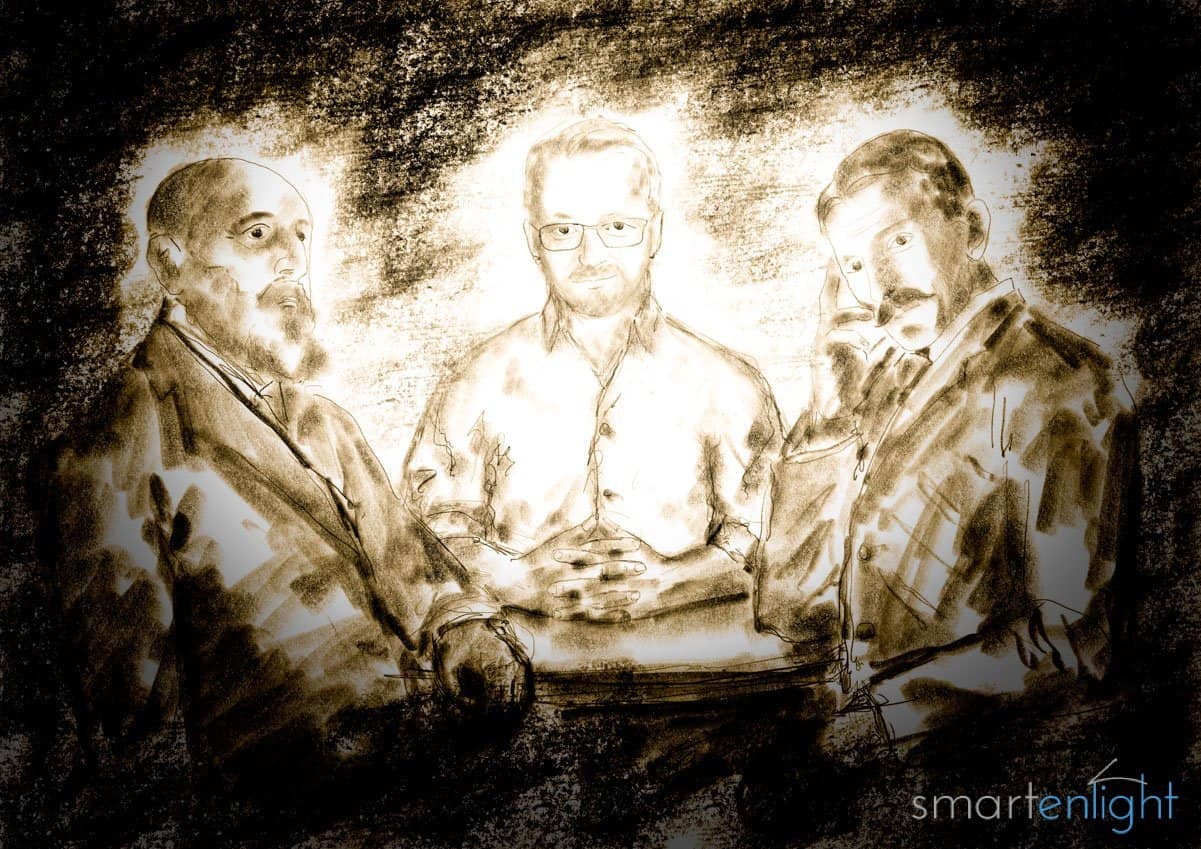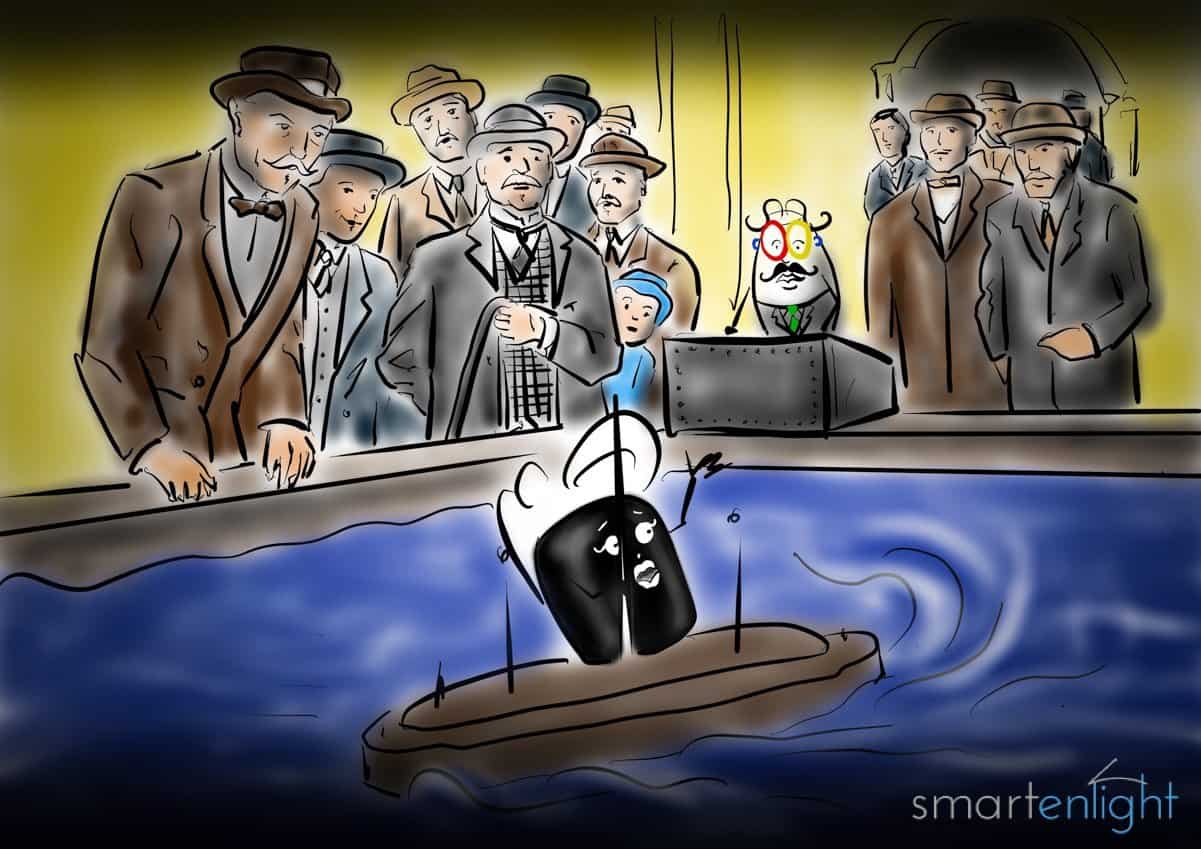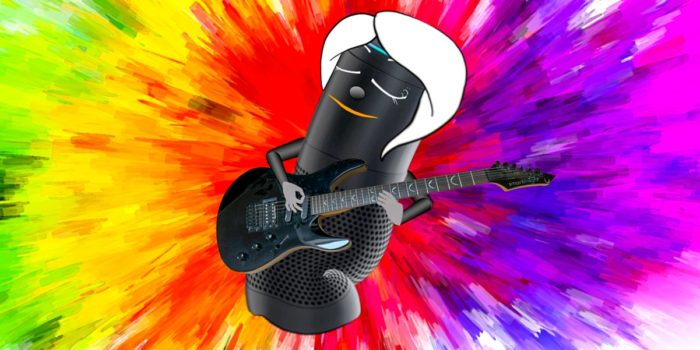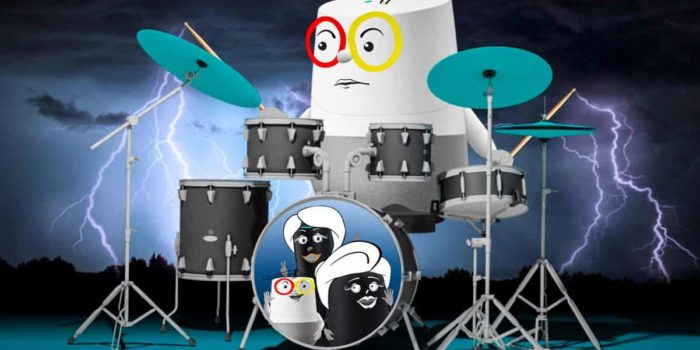It is a rainy September afternoon in New York. We are at the first Electrical Exhibition held at Madison Square Garden. A tall, skinny man is standing next to a big pool, surrounded by an excited crowd. In the pool we see a 4 foot long miniature ship. The man’s mustache is trembling as he commands with slavic accent: “Now, we will move the boat to the rrright!”. The crowd is marvelling at the mini boat, which indeed takes the ordered direction. One man recovering from speechlessness, shouts: “Move it to the left!”, only to freeze open-mouthed in amazement, as the boat follows his command.
Yes, it must have been like that. Otherwise I cannot explain how it comes that some people seriously referred to the event back in 1898, as the first demonstration of voice control.
The First Voice Wireless Remote Control: Teleautomaton
What Nikola Tesla actually did, was demonstrating his remote control. I seriously doubt that Tesla wanted to trick the people into believing that it’s his or the audiences voice, which is operating the boat. He was standing behind his rather big remote control, which he had to operate manually. While he was explaining his demonstration, people were staring at the boat, which was magically moving around. Some just got it plain wrong.
The “teleautomaton”, how Tesla called it, was patented under the title „Method of an apparatus for controlling mechanism of moving vessels or vehicles”. His remote control is based on radio waves and this was first presented by Sir Oliver Joseph Lodge in 1894. Lodge demonstrated at Oxford the similarity of radio waves to light and was able to increase the distance of transmission up to 55 meters. He used a radio signal detector, called “coherer” which is based on findings of Édouard Eugène Désiré Branly in 1890, but this must have been a rather boring demo.
The First Multifunctional Remote Control: “Telekine”
Moving forward in time to the next cool demo, we jump to Paris. It’s 1903, we are at the Paris Academy of Science. A bearded man with spanish accent demonstrates his remote control, with a rather unusual robot. Leonardo Torres y Quevedo “Telekine” resembles a boat, but this time not in water. Ok, another mini boat but without water, maybe the demo was not that great. Anyway, the idea behind it definitely was. His ship robot was able to perform 19 different actions, rather than Teslas 3 (left, right, stop).
From the simple “on/off” mechanisms we saw before, executing an action, depending on whether a signal is received or not, he defined a method for controlling any mechanical or electrical device with different states of operation. A transmitter sends a codeword, in form of a binary telegraph signal, and the receiver can do different things depending on this codeword.
Torres-Quevedo was already some years before that into remote controls. He wanted them for testing his airships without risking some poor pilots life. Though, the first application of his remote control concept was a tricycle, which he was able to control from the distance of around 30 meters, before he actually built his receiver into a real boat which he controlled at the distance of 2 kilometers.
Torres-Quevedo has posthumously received 2007 the IEEE Milestone award for these early developments in remote control in 1901.
Both, Tesla and Quevedo tried to sell their technology to the military, both failed. Both were fed up and stopped working on remote controls.

The First Wireless Radio Remote
During World War II many were working on remote controls for the military. Philco ranked as 57th US military contractor, sold from 1939-1941 the “Mystery Control”, as first consumers wireless remote. The first wireless remote for a radio looked like a monstrous wooden box with a dial-phone, but it was already battery operated.
The First TV Remotes: Visible Light and Ultrasound
Eugene Polley, working for Zenith Electronics, developed the first wireless TV remote control in 1955. It operated with visible light, which was suboptimal. Robert Adler, I usually omit the nationalities, but he was Austrian, invented in 1956 the first wireless sound based remote control, also for Zenith.
Teletext and Infrared
The consumer remotes were pretty simple back at the time with up to 4 buttons. With the advancement of teletext we had to enter numbers and so in 1980 the first infrared wireless remote controls with the well known numeric keypad were developed.
Universal Remotes
In 1985 Philips introduced the first universal remote under the Magnavox brand and marketed it with a “Smart, Very Smart” campaign. This was the first time the term “smart” was coined around consumer electronics.
Even the Woz, sorry I mean Apple co-founder Steve Wozniak, had his startup working on a universal remote in in 1987, but he sold it a year later.
By 2000 every household had too many remotes and people started looking into universal remotes to combine the many into one.
So, where are we today?
Nowadays remotes are not only a convenience feature. Mostly we cannot find the many commands we need on the device itself, but rather on the devices remote. Todays universal remotes come in different shapes and features.
Remote Hubs
Some of them have WIFI hubs, so we can install apps on our smartphones and tablets and use them as remote control. As most electronic devices are using infrared (IR), which requires line of sight, the connection between an actual universal remote control and the hub can be based on radio frequency (RF), which does not require line of sight, so we can hide the many devices in media racks. To make sure that every device gets its IR signal, some hubs provide small IR blasters, which we can place close to the devices. Apart of WIFI and IR, also bluetooth has established as remote control standard and is also supported by some universal remote controls.
The One Remote
The actual universal remotes mostly have programmable touchscreens, motion sensors and vibration feedback for better usability. We can connect them to a Mac/PC, or program them with apps. The configurations we need for our entertainment or smart home devices can be downloaded from a huge database. In case a device is missing, we can teach our remotes to learn the commands (mostly). And last but not least, they are smart and can combine the many actions needed to navigate our entertainment systems into one single activity.
Todays Cool Demo
Today, you could say “Turn on CNN” and: Your lights dim, your TV flips down from the ceiling turning on, receiver and cable box turn on, TV and receiver switch to the right input channel, the cable box to CNN. Voilà, CNN it is.
Though this is a rather common example for what we can do with remote controls today, I believe, Nikola Tesla and Leonardo Torres y Quevedo would be impressed!
I hope you enjoyed this short introduction into smart remote controls and smart entertainment. Appreciate your ideas and feedback in the comments below.
Where to go from here?
Logitech Harmony: a Hub and it’s Elite, Ultimate, Companion will give you an overview of the product line, concepts, setup and features of Logitech Harmony, which we are using since 2010.
In the assistant posts, we look into the setup of Google Home and Alexa to speech enable our remote control:
- Logitech Harmony and Google Assistant: Setup and Voice Commands
- Logitech Harmony and Alexa: Setup, Review and Voice Commands
Finally, we compare the capabilities of our assistants in Assistant Showdown with Logitech Harmony: Who will win, Alexa or Google?.
You’re into music?
Find the detailed music voice commands for all supported music services in these posts:
- Hey Google, Play Some Music! All The Music Voice Commands
- Siri and Apple Music: The Many Voice Commands for HomePod, iPhone, Apple TV, Apple Watch and Mac
- Alexa, Play Some Music: All The Music Voice Commands
If you’d like to know which of our assistants is more musical, see Musical Assistant Showdown: Who will win, Siri, Google or Alexa?
I hope you’ve enjoyed this introduction to smart entertainment!
Still, more to come in this section, stay tuned.
Other Links:
A picture of Nikola Tesla’s Teleautomaton
A picture of Leonardo Torres y Quevedo’s Telekine
IEEE paper on the Telekino of Torres-Quevedo
Gizmondo article with a picture of the Mystery Control
The Logitech Harmony Product Line




